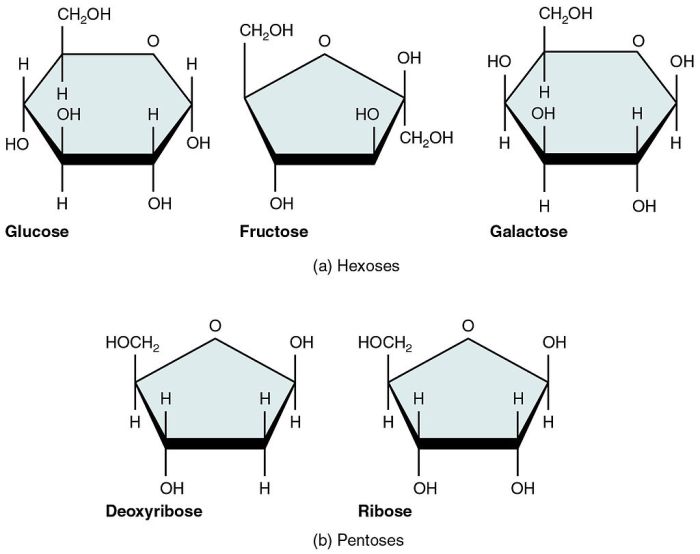Complete the following table regarding monosaccharides and polysaccharides – This comprehensive guide delves into the realm of monosaccharides and polysaccharides, unveiling their chemical structures, biological roles, and diverse applications. By embarking on this journey, readers will gain a profound understanding of these essential carbohydrates.
As we delve deeper into the intricacies of monosaccharides and polysaccharides, we will explore their unique characteristics, compare their functions, and uncover their significance in living organisms.
Monosaccharides

Monosaccharides are simple sugars that serve as the building blocks of carbohydrates. They have the general formula (CH2O)n, where n is typically 3 to 7. Monosaccharides are classified based on the number of carbon atoms they contain, with the most common types being trioses (3 carbons), tetroses (4 carbons), pentoses (5 carbons), and hexoses (6 carbons).Some
common monosaccharides include:
- Glucose: A hexose that is the body’s primary source of energy.
- Fructose: A hexose that is found in fruits and honey.
- Galactose: A hexose that is found in milk and other dairy products.
- Ribose: A pentose that is a component of RNA.
- Deoxyribose: A pentose that is a component of DNA.
Monosaccharides play crucial roles in biological processes, including:
- Energy production: Glucose is the main fuel for cells, providing energy through cellular respiration.
- Structural components: Ribose and deoxyribose are essential components of nucleic acids, which carry genetic information.
- Cell recognition: Monosaccharides on the surface of cells help them recognize and interact with each other.
Polysaccharides

Polysaccharides are complex carbohydrates composed of multiple monosaccharides linked together by glycosidic bonds. They have the general formula (C6H10O5)n, where n is a large number. Polysaccharides are classified based on their structure and function.Some common polysaccharides include:
- Starch: A storage polysaccharide found in plants, composed of glucose units.
- Glycogen: A storage polysaccharide found in animals, composed of glucose units.
- Cellulose: A structural polysaccharide found in plants, composed of glucose units.
- Chitin: A structural polysaccharide found in the exoskeletons of arthropods and fungi, composed of N-acetylglucosamine units.
- Hyaluronic acid: A polysaccharide found in the extracellular matrix, composed of alternating units of glucuronic acid and N-acetylglucosamine.
Polysaccharides perform diverse functions in living organisms, including:
- Energy storage: Starch and glycogen store glucose for later use.
- Structural support: Cellulose and chitin provide structural rigidity to plant cell walls and animal exoskeletons, respectively.
- Cell signaling: Hyaluronic acid is involved in cell signaling and tissue repair.
- Lubrication: Hyaluronic acid lubricates joints and other tissues.
Comparison of Monosaccharides and Polysaccharides

Monosaccharides and polysaccharides differ in their chemical structures and functions:
- Chemical structure:Monosaccharides are simple sugars with a single sugar unit, while polysaccharides are complex carbohydrates composed of multiple monosaccharides linked together.
- Molecular weight:Monosaccharides have a lower molecular weight than polysaccharides.
- Solubility:Monosaccharides are generally more soluble in water than polysaccharides.
- Function:Monosaccharides primarily serve as energy sources and structural components, while polysaccharides mainly function as energy storage, structural support, and cell signaling.
The following table summarizes the key differences between monosaccharides and polysaccharides:
| Property | Monosaccharides | Polysaccharides |
|---|---|---|
| Chemical structure | Single sugar unit | Multiple sugar units linked together |
| Molecular weight | Lower | Higher |
| Solubility | More soluble | Less soluble |
| Function | Energy source, structural components | Energy storage, structural support, cell signaling |
Applications of Monosaccharides and Polysaccharides
Monosaccharides and polysaccharides have various industrial and commercial applications:
- Monosaccharides:
- Sweeteners: Glucose and fructose are used as sweeteners in food and beverages.
- Pharmaceuticals: Monosaccharides are used in the production of antibiotics and other drugs.
- Biofuels: Monosaccharides can be fermented to produce biofuels, such as ethanol.
- Polysaccharides:
- Food additives: Starch is used as a thickener and stabilizer in food products.
- Paper and textiles: Cellulose is used in the production of paper, textiles, and other materials.
- Biodegradable plastics: Chitin and other polysaccharides are used in the development of biodegradable plastics.
- Medical applications: Hyaluronic acid is used in cosmetics, joint injections, and wound healing.
As research continues, new applications for monosaccharides and polysaccharides are constantly being discovered, promising further advancements in various fields.
Helpful Answers: Complete The Following Table Regarding Monosaccharides And Polysaccharides
What are the key differences between monosaccharides and polysaccharides?
Monosaccharides are simple sugars consisting of a single sugar unit, while polysaccharides are complex carbohydrates composed of multiple monosaccharide units linked together.
What are some examples of monosaccharides and polysaccharides?
Common monosaccharides include glucose, fructose, and galactose, while starch, cellulose, and glycogen are examples of polysaccharides.
What are the biological roles of monosaccharides and polysaccharides?
Monosaccharides serve as the primary energy source for cells, while polysaccharides provide structural support and energy storage in organisms.